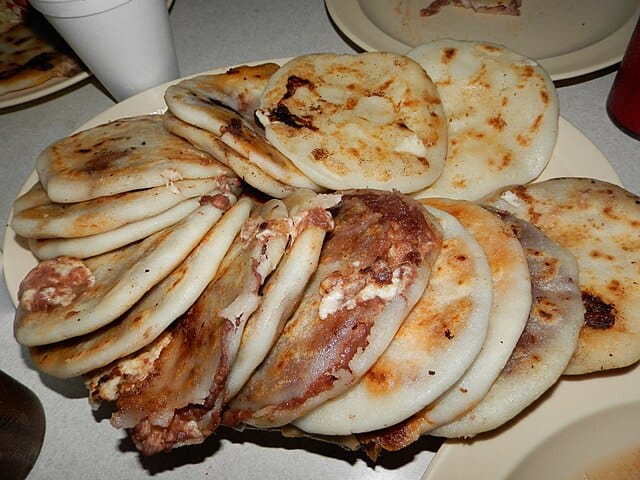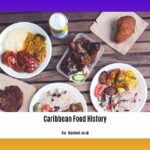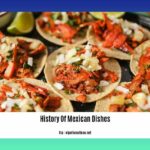Embark on a tantalizing journey through time as we unveil the captivating history of the pupusa, a beloved Latin American delicacy. From its ancient Mesoamerican roots to its cherished status as a national symbol, we’ll uncover the fascinating stories and traditions that have shaped this iconic dish. Join us as we explore its humble beginnings and trace its evolution through centuries of cultural exchange and culinary innovation, leaving you with a newfound appreciation for the pupusa’s rich heritage.
History of the Pupusa
The pupusa: a food that makes mouths water in Latin America and beyond. But this delicious treat isn’t just a tasty meal – it has a story to tell, a story that likely takes us back centuries.
Archeological evidence suggests that something resembling the pupusa we know and love was already being enjoyed as far back as the 1800s in Nicaragua. Our journey then takes us to the Pipil people of El Salvador. Before Europeans arrived, they had already mastered a special kind of pupusa. This wasn’t just any pupusa, though. Theirs was a vegetarian delight, shaped like a half-moon, and probably cooked on hot stones over a fire.
The Pipil spoke a language called Nahuat, and experts believe the word “pupusa” comes from their word “pupusawa,” meaning “to puff up.” And that’s exactly what happens when you cook a pupusa just right – it plumps up like a little pocket of deliciousness.
Fast forward to the 1960s and 1970s, when many Salvadorans began migrating to new lands, bringing their traditions and, of course, their recipes with them. This is how the pupusa started winning hearts in the United States, Canada, and even as far away as Australia.
Today, the pupusa is a symbol of Salvadoran culture, a dish that brings people together. From its humble beginnings to its global popularity, the pupusa’s story is a reminder that some of the best things in life are often the simplest.
Who Invented the Pupusa?
So, you’re curious about the pupusa’s origins? Who could blame you! This delicious dish has a past shrouded in mystery. While we can’t say for sure who invented it, we can dig into the history of the pupusa and explore the different theories.
Both El Salvador and Honduras claim to be the birthplace of this savory treat, and honestly, they both make pretty convincing cases. El Salvador proudly points to the Pipil people, who lived there in pre-Columbian times. As we mentioned, the word “pupusa” itself seems to come from their language, translating to “swollen.” The Pipil people were known for making vegetarian pupusas in that classic half-moon shape, cooking them on hot stones.
But hold on! Honduras isn’t backing down so easily. They point out that the Pipil language has a lot in common with Nahuatl, the language of the Nahua people who lived in Honduras. This little detail throws a wrench in the works because it means the Nahua people could very well have been the original pupusa innovators.
Adding to the intrigue, the word “pupusa” itself is like a linguistic puzzle! While some experts think it comes from the Nawat word “Puxahua,” meaning “fluffy thing,” others point to “Pupusawa” – “to puff up” – also in Nawat. And then there’s the K’iche’ word, “Poputz,” meaning “good sphere.”
The first official record of pupusas actually pops up in Nicaragua in 1837. Since then, the pupusa has been on quite the journey, changing and adapting with new ingredients and cooking styles. It’s a testament to the incredible mix of cultures that make Central American cuisine so unique and delicious.
So, while we might never know for sure who invented the pupusa, one thing is certain: this culinary masterpiece is a gift to be enjoyed, no matter where it came from.
What is the Cultural Importance of Pupusas?
Pupusas aren’t just a tasty treat in El Salvador; they’re deeply woven into the fabric of everyday life and national identity. They are a symbol of resilience, having been around for centuries, feeding generations who have faced their share of challenges. The simple act of creating something so delicious from basic ingredients speaks volumes about the Salvadoran spirit; it’s about finding joy and sustenance even in difficult times.
Pupusa-making is rarely a solo affair; it’s a social event, a reason for families and friends to come together. It’s a beautiful example of how food strengthens bonds and creates lasting memories.
For many Salvadorans abroad, the humble pupusa brings a taste of their homeland and evokes a wave of nostalgia. It’s a reminder of their roots, a source of comfort, and a way to connect with their heritage. It’s no wonder that in 2005, pupusas were officially declared El Salvador’s national dish, a title that reflects their profound impact on national pride.
The cultural significance of pupusas goes even deeper, linking back to El Salvador’s indigenous history and agricultural traditions. The main ingredients – corn, beans, cheese, and sometimes loroco (an edible flower bud native to Central America) – are all staples of the region, reflecting a deep connection to the land. Each bite is like a taste of history, a reminder of ancestral knowledge passed down through generations.
While we’ve uncovered some key aspects of the pupusa’s cultural importance, there’s always more to explore. Researchers continue to study the evolution of pupusas, their regional variations, and their impact on Salvadoran communities worldwide. One thing is for sure: these little pockets of deliciousness hold a rich and fascinating story that continues to unfold.
What Are Some Interesting Facts About Pupusas?
Did you know that pupusas have been around for ages – possibly as far back as 2000 BC? The ancient Pipil people of El Salvador might have been whipping up these tasty treats all those years ago! It’s like taking a bite out of history.
One of the coolest things about pupusas is their variety. You’ve got your classics, of course, like ooey-gooey cheese and fragrant loroco (an edible vine flower). But then you can get adventurous with savory chicharrón (crispy pork) or keep it simple with hearty beans. And these are just a few examples! You can probably find a pupusa out there with almost anything you can imagine.
But don’t let the casual street food vibe fool you; making a perfect pupusa is an art. From getting that corn masa dough just the right thickness and texture to carefully sealing in all that yummy filling without a single spill, it takes a practiced hand. It’s like a culinary dance, and the result is a symphony of textures and flavors.
And the best part? You don’t have to travel to El Salvador to find them anymore. Pupusas have pretty much taken over the world! From the streets of LA to markets in London, you can find people everywhere falling in love with their deliciousness. It’s heartwarming to see a dish with such humble beginnings become a global culinary superstar.
Is the Pupusa Mexican or Salvadoran?
So, we’ve been talking about pupusas, and you might be wondering where these delicious pockets of goodness actually come from. It’s a bit of a culinary mystery, with both El Salvador and Honduras throwing their hats into the ring, each claiming to be the true birthplace of the pupusa.
El Salvador points to the language of the Pipil, their indigenous people, as proof. They say the word itself has roots in their ancient tongue. Meanwhile, Honduras counters with their own claim, suggesting the Nahua people, another indigenous group, were the real masterminds behind the pupusa. They’ve got some historical arguments on their side, too.
But hold on, there’s a twist! Archeologists digging around in Nicaragua in 1837 found some intriguing evidence: the first official record of pupusas. Talk about a plot twist!
And what about the word “pupusa” itself? Well, nobody’s 100% sure, but some language buffs believe it could be from the Nahuatl, Nawat, or even K’iche’ languages. They all have words that mean something like “to puff up” or “good sphere,” which, let’s be honest, sounds about right when you think about a perfectly plump pupusa.
Despite all this back and forth, one thing’s for sure: El Salvador has wholeheartedly embraced the pupusa as their own. It’s become a national treasure, a symbol of their culture and history that’s deeply intertwined with their identity. You’ll find pupusas everywhere in El Salvador, from street food stalls to fancy restaurants. They’re a source of national pride and a reminder of their rich culinary heritage.
Think of it this way: Imagine a family recipe passed down through generations. Each family might have their own version of the story, their own little tweaks to the recipe, but the end result is a dish that’s loved and cherished by everyone. That’s kind of what the pupusa is like – a delicious testament to the ingenuity and resilience of the people who created it, regardless of where it truly originated.
Are Salvadorans Mayans or Aztecs?
It’s a common question, but the answer isn’t as simple as a “yes” or “no.” While Salvadorans have a rich indigenous heritage, it’s important to remember that this heritage comprises many different groups, not just one. While the Maya are certainly part of the story, so are the Lenca and Pipil peoples, each contributing to the unique cultural tapestry of El Salvador.
Think of it like this: El Salvador is like a delicious dish with a complex flavor profile. The Maya influence is a strong ingredient, for sure, but you can also taste hints of Lenca and Pipil traditions in the mix. This blend of influences is what makes Salvadoran culture so fascinating.
Now, about those Aztecs. While they were a powerful force in Mesoamerica, their influence didn’t quite reach El Salvador in the same way it did other regions. Although there were some Nahuatl-speaking communities in El Salvador, they weren’t actually Aztec. Imagine it like this: just because someone speaks English doesn’t automatically make them British, right? It’s similar with the Nahuatl language; speaking it doesn’t automatically equate to being Aztec.
The Maya, however, definitely left their mark on El Salvador. They were a flourishing civilization in the region, but even their influence wasn’t constant. The eruption of the Ilopango Volcano had a significant impact on Mayan life, disrupting their settlements and likely causing widespread changes.
Here’s the bottom line: Salvadoran heritage is a tapestry woven from many threads. The Maya influence is undeniable, but it’s crucial to recognize the Lenca and Pipil contributions as well. Although the Aztecs didn’t have a strong presence in El Salvador, their story remains an important part of the broader Mesoamerican narrative.
Just remember: History is rarely black and white. As researchers continue to uncover new information, our understanding of the past continues to evolve.
Are Salvadorans Hispanic or Latino?
Salvadorans are often described using both terms, “Hispanic” and “Latino,” and understanding why gets into some interesting cultural and historical territory. Let’s break it down: The term “Hispanic” centers around language. Since El Salvador’s official language is Spanish, its people are considered Hispanic. “Latino,” on the other hand, is broader. It covers anyone with roots in Latin America, including South America, Central America (where El Salvador is), and parts of the Caribbean. So, someone from El Salvador is both Hispanic and Latino.
Now, you might wonder why this distinction matters. Well, within the U.S., these labels significantly impact how we talk about things like population demographics, access to resources, and even cultural trends. Salvadorans, for example, make up a noticeable chunk of the Hispanic population in the U.S. – around 4%. That’s a lot of people!
Here’s another layer: The experiences of Salvadorans in the U.S. don’t perfectly match up with other Hispanic groups. For instance, a higher percentage of Salvadorans living in the U.S. were born outside the country. Plus, there are some differences in educational attainment levels compared to other Hispanic communities. This means that when researchers or policymakers lump all Hispanic people together, they might miss some of the unique challenges or successes that Salvadorans face.
Of course, no cultural group is a monolith. Within the Salvadoran community itself, you’ll find a ton of diversity – different family histories, different ways of speaking Spanish, different takes on traditions. But, there are some common threads that tie many Salvadorans together. One delicious example is the pupusa. This thick, savory tortilla, often stuffed with cheese, beans, or meat, is like a culinary ambassador of El Salvador. You’ll find it at Salvadoran restaurants and homes both in the U.S. and back in El Salvador – a taste of home and a point of pride.
Speaking of home, the story of why there are so many Salvadorans in the U.S. is deeply intertwined with history. Back in the 1960s and 1970s, El Salvador went through a rough period of political turmoil and economic hardship. Many people fled, seeking safety and a better life, and a significant number ended up in the U.S. This wave of immigration significantly impacted, contributing to the growth and richness of Hispanic culture within the United States.
To sum it up: Yes, Salvadorans are both Hispanic and Latino. But beyond those labels lies a vibrant community with a unique history, delicious food, and an ongoing story that continues to shape the tapestry of the United States.
Did Mexico Invent Pupusas?
While pupusas are a hot topic (pun intended!) and you might find them sizzling on street corners from Los Angeles to Mexico City, their roots don’t actually lie in Mexico. Pupusas are about as Salvadoran as it gets! Think of them like the stars of El Salvador’s culinary show. They even have their own national day in El Salvador – that’s how much they love them there!
The story goes way back to pre-Columbian times. The Pipil people, who lived in the area that is now El Salvador, were likely the first to whip up these delicious pockets of goodness. The word “pupusa” itself seems to come from their language – “pupusawa” – which means “to puff up.”
Now, both El Salvador and Honduras sometimes claim pupusas as their own. It’s a bit of a friendly food fight! But honestly, pinpointing their exact birthplace is kind of like trying to find the world’s first tortilla – a delicious mystery. What we do know is that the historical and linguistic evidence points towards those ancient Pipil cooks.
What started as a local treat has now gone global! Pupusas have become a beloved dish across Central America and beyond, popping up on menus worldwide. From classic cheese and bean fillings to more adventurous options like loroco flowers (a unique Central American ingredient) or even shrimp, there’s a pupusa out there for everyone. So, while their exact origins might remain a bit murky, one thing’s for sure: pupusas are a testament to the power of culinary tradition and the simple joy of a truly tasty dish.
Is El Salvador a Spanish-Speaking Country?
So, we’ve been talking about El Salvador, and you might be wondering, “Can I get by with just English?” Well, the short answer is: probably not. You see, El Salvador is a Spanish-speaking country through and through. It’s not just the official language; it’s deeply woven into the fabric of everyday life.
Think back to the 16th century when Spanish explorers first landed in El Salvador. They weren’t exactly there for a quick visit. They set up shop, making El Salvador part of the Spanish Empire for a good three centuries. During that time, Spanish became the language of everything official – the government, schools, you name it. It’s no surprise that by the time El Salvador declared its independence in 1821, Spanish was already firmly rooted as the main language.
Now, don’t expect textbook Spanish. Salvadorans, like people anywhere, have their own way of speaking. For example, they might use “vos” instead of “tú” when talking to someone casually. And if you hear some sounds that seem a bit like “s” where you’d expect a “c” or “z”, don’t worry, that’s normal in Salvadoran Spanish. It’s all part of what makes their dialect unique.
But here’s the cool part: Even with these differences, someone speaking Salvadoran Spanish and someone speaking Spanish from, say, Spain, could still understand each other pretty well. It’s like how someone from Texas and someone from London can still have a conversation in English, even if their accents and slang are worlds apart.
The takeaway here is simple: If you’re planning a trip to El Salvador, brushing up on your Spanish is a must. It’ll not only help you navigate the country but also allow you to connect with the locals and their vibrant culture on a deeper level.
Why Do Salvadorans Like Pupusas?
Salvadorans’ love for pupusas goes far beyond a simple craving for delicious food. It’s almost like these thick, cheesy discs of goodness are woven into the very fabric of their culture. Let’s dive into a few reasons why pupusas hold such a special place in the hearts (and stomachs) of Salvadorans.
- More Than Just a Meal: Imagine biting into a pupusa – the warm, slightly crispy tortilla gives way to savory fillings, creating a burst of flavor that’s uniquely Salvadoran. This experience isn’t just about satisfying hunger; it’s about connecting with a cherished national symbol. It’s a reminder of home, heritage, and identity, all wrapped up in a comforting and familiar package.
- Bringing People Together: In El Salvador, food isn’t just fuel; it’s the heart of social gatherings. Families and friends gather ’round, sharing laughter and stories as they enjoy pupusas together. This shared experience strengthens bonds and creates lasting memories, making pupusas a symbol of unity and togetherness.
- A Taste of History: The story of the pupusa likely stretches back centuries to El Salvador’s indigenous Pipil people. They used readily available ingredients like corn and local fillings, establishing a culinary tradition that has endured for generations. Each bite offers a tangible connection to the country’s rich past, a reminder of resilience and resourcefulness.
- A National Treasure: Pupusas aren’t just enjoyed on the street corners and in homes across El Salvador; they’ve earned a place on the national stage! National Pupusa Day, celebrated every November, is a testament to the deep love and pride Salvadorans feel for this iconic dish. It’s a day for national celebration, where everyone can come together and appreciate the simple perfection of a well-made pupusa.
While we may never fully unravel all the reasons behind this national obsession, one thing’s for sure: Salvadorans’ love for pupusas is a beautiful example of how food can transcend mere sustenance and become a powerful symbol of culture, community, and national identity.
What is My Race if I Am From El Salvador?
Exploring Salvadoran racial identity is a journey into a nuanced and fascinating aspect of the country’s cultural makeup. Imagine a place where indigenous roots mix with European influences, creating a vibrant blend of cultures and backgrounds – that’s El Salvador!
Unpacking the Ancestry of El Salvador
Think of El Salvador’s population like a beautiful mosaic, with tiles representing indigenous, European, and even African ancestries. It’s this mix that makes understanding race in El Salvador so fascinating. A large number of Salvadorans, around 58%, identify as White, which makes sense considering the country’s history marked by periods of colonization and European immigration.
However, about 27% of Salvadorans choose “some other race” on surveys. This suggests that they recognize the indigenous side of their heritage, acknowledging a lineage that goes beyond simple categories.
The Hispanic Factor: Culture Versus Classification
It’s important to differentiate between race and ethnicity. While race is often based on physical characteristics, ethnicity delves into shared cultural experiences, languages, and traditions. In El Salvador, you can be both Hispanic and White! “Hispanic” speaks to the cultural connection to a shared Spanish-speaking heritage, while “White” is a racial classification. The majority of Salvadorans, a whopping 91%, identify as Hispanic, which demonstrates the country’s diversity.
Thinking Beyond the Checkbox: Exploring Broader Perspectives
Traditional racial categories, like those checkboxes on forms, don’t always capture the whole picture. That’s why it’s important to consider things like self-identified skin color or even how people describe their race in their own words. These alternative measures give us deeper insights into how Salvadorans perceive themselves and how they fit into society. You’ll find that these personal experiences often paint a much more complex and nuanced picture of racial identity.
Here are some key takeaways about race in El Salvador:
- While many Salvadorans identify as White, a significant portion acknowledge a mixed heritage by choosing “some other race.”
- Being Hispanic and being White aren’t mutually exclusive in El Salvador. You can identify with both, highlighting the distinction between cultural heritage and racial classification.
- To truly understand racial identity in El Salvador, we need to look beyond simple checkboxes and consider the individual stories and experiences that shape people’s perceptions
Remember, this is just the tip of the iceberg. Understanding race and identity in El Salvador, or anywhere for that matter, is an ongoing conversation. As we continue to learn from each other and challenge traditional ways of thinking, we gain a richer understanding of ourselves and the world around us.
Want to learn more about history and culture? Explore these fascinating articles:
- Embark on a fascinating historical journey to uncover the history of the nunchaku and delve into the intriguing stories that lie behind this martial arts weapon.
- Unravel the captivating history of the Olde Pink House Savannah GA, a renowned landmark that has witnessed centuries of Southern history and architectural splendor.
- Immerse yourself in the annals of empires past with the history of the Ottoman Empire podcast, a captivating audio series that explores the rise, reign, and eventual fall of one of the world’s most powerful empires.
- China II Review: Delicious Food & Speedy Service - April 17, 2025
- Understand Virginia’s Flag: History & Debate - April 17, 2025
- Explore Long Island’s Map: Unique Regions & Insights - April 17, 2025
















